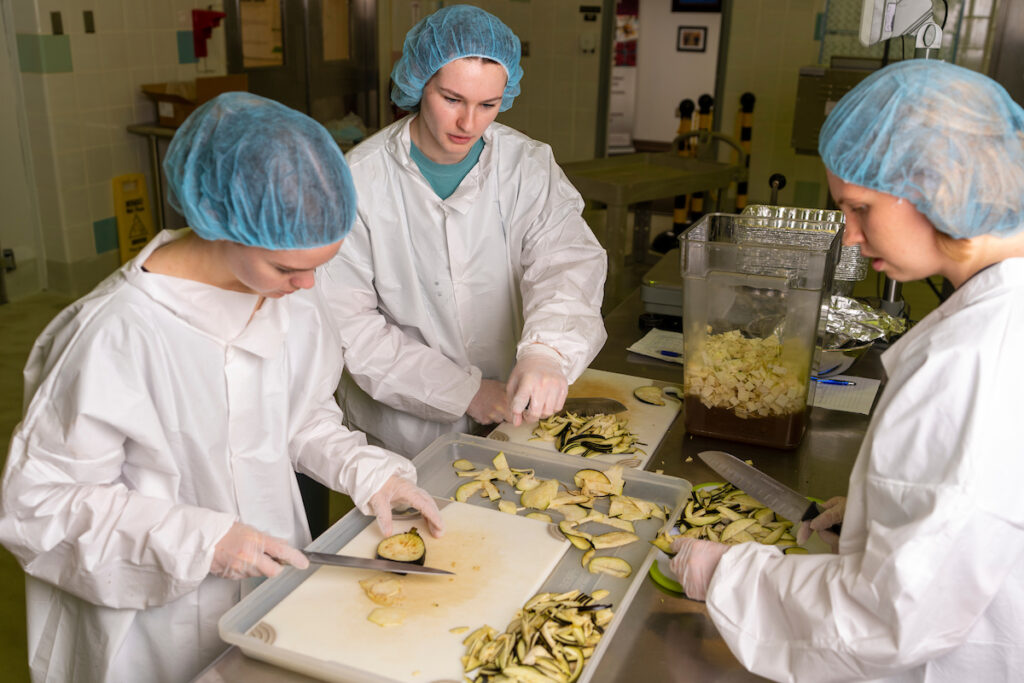Key Teaching and Research Missions
Provide an unparalleled opportunity for food science and technology undergraduate and graduate students to obtain hands-on experiential learning on food processing technologies. The students who are hired as student researchers at the Space Food Research Facility (SFRF) work closely with NASA and its contractor (KBR) to prepare foods for the US astronauts on the International Space Station (ISS). The students’ primary focus is to assist NASA in preparing thermostabilized foods for the ISS.
The SFRF is unique in that it provides both government, industry, and academic scientists the opportunity to investigate the combination of a variety of food processing technologies such as electron beam (eBeam) pasteurization along with legacy technologies that NASA and its space partners utilize.
Some of the research projects have involved exploring the use of eBeam processing with lyophilization for highly perishable commodities such as fresh fruits to prevent fungal infestation. The research mission of the SFRF is to expand the portfolio of food processing technologies that are available to the government and private space industry.
Process Capabilities

The SFRF is equipped with a variety of unit processes for preparing the foods and for long-term food preservation in support of NASA’s activities. The equipment at the facility can be used for:
- Thermostabilizing the foods
- Modified Atmosphere packaging of foods
- Vacuum sealing of foods
- Freeze-drying foods and
- Canning foods
In partnership with the eBeam facility, the foods can also be preserved by combining one or more legacy food processing methods with eBeam processing.
Photos by:
Michael Miller/Texas A&M AgriLife Marketing and Communications. NASA Space Food Research Facility AgriLife Today Story, April 18th 2023:
Primary Equipment
The main pieces of equipment include:
- Audionvac Vacuum Sealer
- Cleveland Steam Kettle
- CSC Scientific Bostwick
- Dixie Canner
- Hobart Bowl Chopper
- Hobart Deli Slicer
- Hobart Dual Convection Oven
- Hobart Mixer with Attachments
- Hobart Range and Oven
- Leibinger Jet 3 Printer and Others
- Millrock Freeze Dryer
- Refractometers
- Retort System
- Robot Couple Food Processor
- Robot Coupe Immersion Blender
- Simplex Filler
- TM Electronics Burst Tester
Impact
This facility is of national and international significance. It keeps the US astronauts fed in space and is the corner stone of all manned space missions. The activities of this facility will expand with the expanding commercialization of space.
This is the only facility of its kind in the US. This is an example of Texas A&M University’s leadership in forging an academic-government-private collaboration.
Current or Past Projects Associated with Facility
The following are projects that have been completed using the capabilities of the SFRF
2015
Bhatia, S.S., and S.D. Pillai.
Benchmarking the minimum electron beam dose required to achieve sterility of space foods. Texas branch meeting of the American Society for Microbiology. Huntsville, October
2016
Bhatia, S.S., C. Kerth, and S.D. Pillai.
Benchmarking the minimum electron beam (eBeam) dose required to achieve sterility of space foods. International Meeting of Radiation Processing (IMRP), Vancouver, November
Bhatia, S.
Benchmarking the minimum electron beam (eBeam) dose required to achieve sterility of space foods. Undergraduate Research Scholars Program Thesis, Texas A&M University
2017
Smith, B., A. Ortega, and S.D. Pillai.
Preserving Quality of Fresh Cut Watermelon Cubes for Vending Distribution by Low-Dose Electron Beam Processing. Food Control 72: 367-371
2018
Bhatia, S. K., R. Wall, C. R. Kerth and S.D. Pillai.
Benchmarking the minimum Electron Beam (eBeam) dose required for the sterilization of space foods. Radiation Physics Chemistry. 143: 72-78
2019
O’Neil, B.R.
Evaluating the application of electron beam technology on freeze-dried berries for fungal decontamination. Masters thesis, Texas A&M University